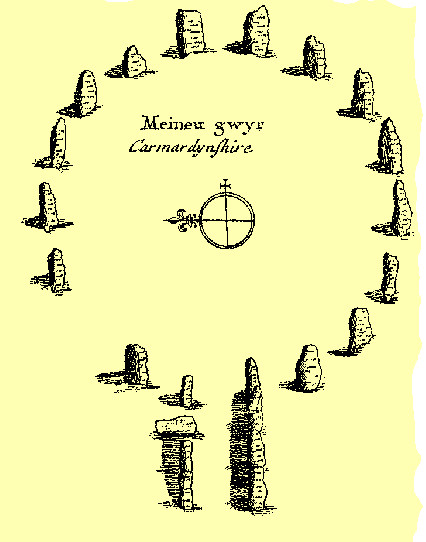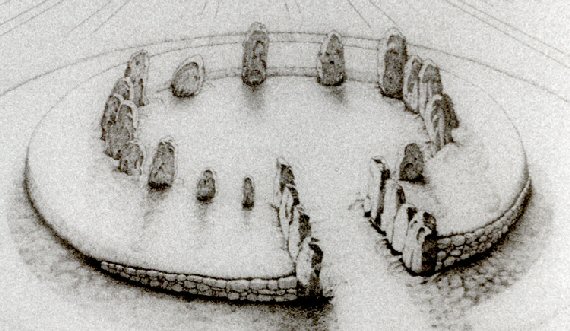|
Location:
Glandys Cross,
Pembrokeshire,
Wales. |
Grid Reference:
51� 54' 23.07" N, 4� 42' 4.79" W. |

 Meini Gwyr:
(Henge-Circle IC).
Meini Gwyr:
(Henge-Circle IC).
The Meini Gwyr monument is unique in Welsh prehistoric
architecture, being the only known raised henge-circle.
Sadly, all that remains of this once impressive
construction is two lone stones in a field.
The location of this important 'ceremonial' structure
so close to the source of the Stonehenge 'Bluestones' and the
Gors Fawr
circle make it likely that it was once an integral part of the local
Neolithic landscape
(Map with location)
|
Meini Gwyr:
('Buarth Arthur') |
Meini
Gwyr has been almost entirely demolished over the centuries, with the last two
combining to cause more damage than the previous thirty or forty. The notice board at the gate describes the state of
the site a couple of hundred years ago as a henge combined with a circle
of large stones, and an entrance-way of more than usual complexity,
consisting of a stone-lined passage through the earth bank.

Sketch
made by William Stukeley (1687-1765).
'The embanked, sub-circular enclosure at Meini Gwyr
measures c.20-22m in diameter, having a NW facing entrance. An excavation in
1938 showed that two extant stones were the survivors of 19 stones that
originally ringed the interior of the earthwork. The entrance was lined by a
'palisade' of lesser stones, whilst e.19th century reports speak of two
avenues of stones approaching the enclosure'. (1)

Artistic impression of the monument in its
complete form.
The text on the information sign (supplied by the Dyfed
Archaeological Trust Ltd) reads as follows:
Meini Gwyr, also known as Buarth Arthur, is an
embanked stone circle probably dating to the transition between the late
Neolithic and early Bronze Age periods. The site is likely to
have been used for religious rituals.
According to a late 17thC account by Edward Lhuyd, there
were then fifteen stones in the circle ranging in height from three to six
feet, but a further seven or eight were thought to have been 'carried off'.
Apparently, there was also an entrance lined by smaller slabs.
The site was partially excavated in 1938 by Professor W.F. Grimes.
Unfortunately most of the records were destroyed in a bombing raid on
Southampton in 1940. The plan is based partly on ground and air photographs
of the excavation. Grimes established that the circle, some 60 feet in
diameter, originally consisted of 17 stones which, like the two surviving
ones, were set at an angle into the inner slope of the bank about 3 feet
height and 120 feet in the external diameter, with no trace of a ditch. The
excavations confirmed that the entrance through the earthwork was formerly
flanked by upright stones, set in a trench. The bank was set with stone curb
extending for some 30 feet on either side of the entrance, in front of which
was a clay-filled pit containing a large quantity of charcoal. There were no
features or finds recorded from the interior, though this was only partly
examined. Some fragments of early Bronze Age pottery came from a hearth set
in a deep depression on the southeast bank.
Meini Gwyr stands at the centre of 'West Wales' most important complex of
Neolithic and Bronze Age ritual and funerary monuments, lying on a ridge-way
linking the wester end of the Preselis to the eastern Cleddau river and
Milford Haven. This was a route by which the bluestones for Stonehenge may
have been transported. Included in the complex are several Bronze Age burial
mounds and cairns or various forms, and a 'henge' monument (akin to early
elements at Stonehenge). Also, there is the site of 'Yr Allor' ('The Altar')
comprising two, formerly three standing stones some 200 yards west of Meini
Gwyr and apparently known by the 17thC. These stones may be the remains of a
chambered tomb.
Carn Meini, a source of the bluestones lies only 3 miles to the north. The
site's name - 'Meini' ('large stone') and 'Gwyr' ('crooked') may refer to
the varying size, shape or angle of the stones set in the circle. These were
not 'bluestones' but another form of volcanic rock. Many such boulders are
found locally and were originally deposited by glacial action. The
alternative name 'Buarth Arthur' ('Arthur's Yard') is an example of a common
legendary association of this figure with prehistoric stone monuments and is
not regarded as significant.
Note: The nearby standing stones called the 'Altar' are
on private land.
(Other Welsh Sites)
|